
Last updated November 17, 2021
First, some background...
I helped pioneer Amateur Radio Laser communications in the late 1970s. Did some mountaintop VHF/UHF/Microwave contesting with the Los Padres group headed by W6OAL with 6M/2M/220/432/1296/10GHz/474THz (HeNe Laser.)
All my Laser records were set with equipment of my construction and all were two-way contacts.
June 9, 1979 15 miles / 24 km 474.1 THz between Mount Pinos and Reyes Peak, Ventura County California. 4 mW HeNe lasers and 931A photomultiplier receivers.
April 22, 1990 18.2 miles / 29.25 km 474.1 THz between South Mountain and Red Mountain, Ventura County. 2.5 mW HeNe lasers and C7138 S10 photomultipliers.
June 9, 1991 57.7 miles / 92.8 km 474.1 THz between Frazier Mountain and Bissell California. 2.5 mW HeNe lasers and C7138 S10 photomultipliers.

What's Happening Today...
Back in the game now that I'm retired after 22 years as senior test engineer at Advanced Photonix where I developed test systems for custom photodiodes and LEDs. (Apparently, I just can't get enough of this stuff!) First step is to figure out what the goal is. Balls-out distance records? Contest points? Technical curiosity? I have no desire to go mountaintopping again so distance records are not of interest. I would like to build transceivers that are portable, inexpensive, and easy to use.
What approach to take - Lasers or LEDs?
At this point I am focusing on LED light sources. This is because one of my goals is ARRL contest points and the ARRL limits laser power to 5 mW (which I do not object to) with no limit on LED power output. Plus, visible lasers have the hazard of freaking people out. Another goal is to see if two-way optical communications of several miles in full daylight is possible.
Not wanting to reinvent the wheel I am adapting the excellent circuit designs of KA7OEI: http://www.modulatedlight.org/optical_comms/optical_rx2.html
The receiver circuit is amazing at being able to receive signals in the presence of background light. Modulation is basic AM. BTW, sticking with silicon photodiodes. Detector comparisons have been done plenty well in the past so there is no point in going over that again. The only thing hotter is a photomultiplier tube but their spectral sensitivity is poor in the red and infrared, at this point not worth the trouble. I did use PMTs for my first contacts. It is important to pick a detector with an active area that will capture most of the energy from whatever lens or mirror you are using, but not so large that its capacitance doesnt restrict bandwidth.
I started with the highest power and narrowest beamwidth visible red and infrared T 1-3/4 LEDs that I could find. Those are the Vishay VLCS5830 624nm 8-degree 65cd LED and the Osram SFH4550 850nm 6-degree 70mW IR LED. Fifteen of the red VLCS5830 and 17 of the IR SFH4550 were press-fit in precisely drilled holes a thick plastic disc mounted on the transceivers. This guarantees that all the LEDs pointed in exactly the same direction maintaining the advantage of their narrow beam divergence. Signals from this were copyable in full daylight at one mile distance.
First cut at opto transceivers.
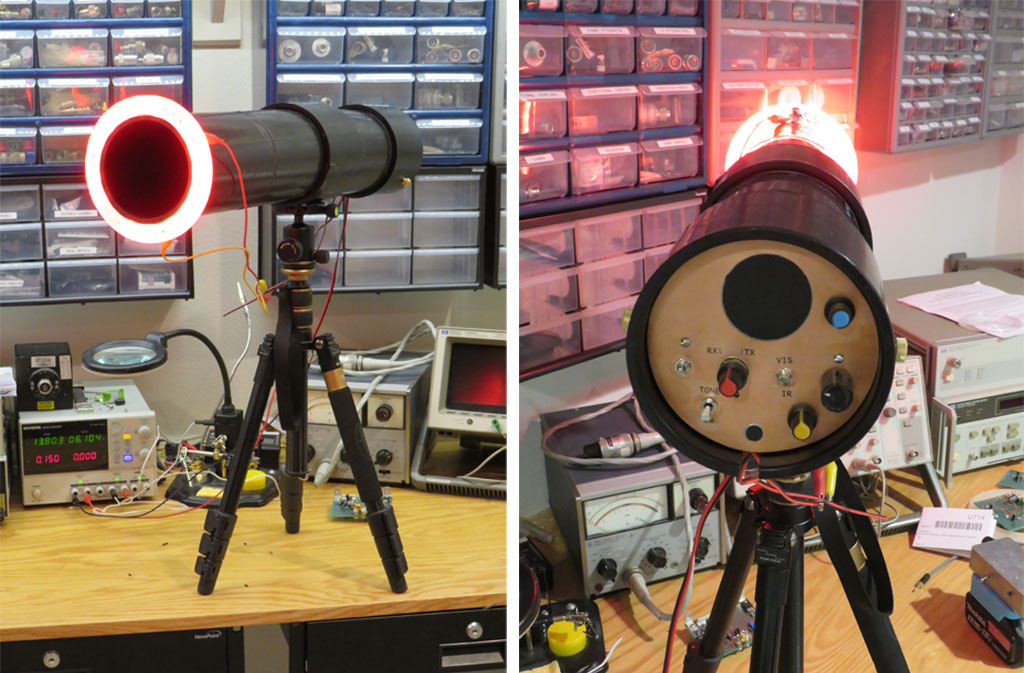
First cut at opto transceivers.
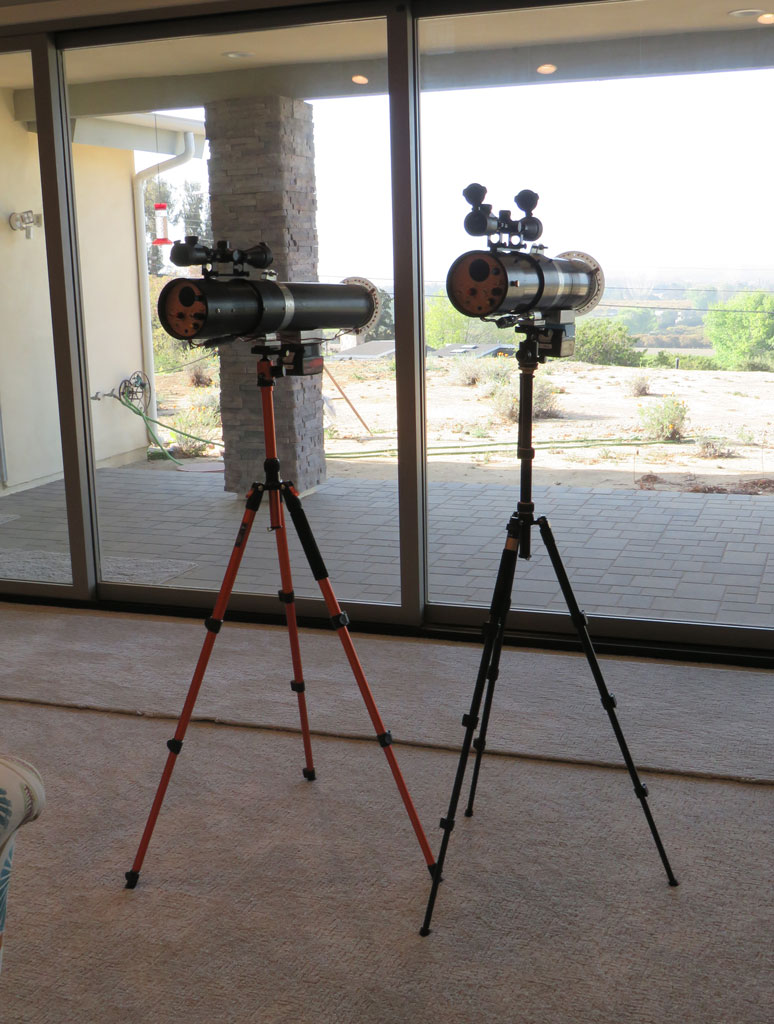
LED end.
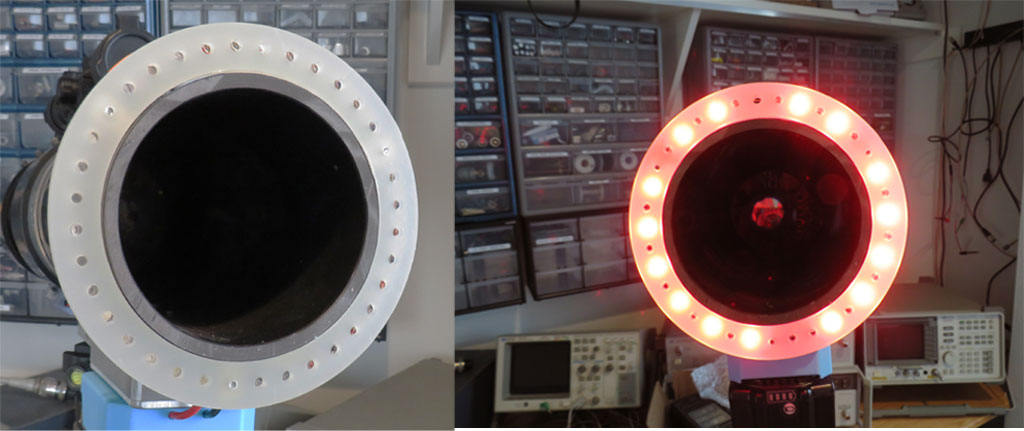
Transceiver control panel.

While the Vishay VLCS5830 624nm 8-degree 65cd LEDs and the Osram SFH4550 850nm 6-degree 70mW IR LEDs are impressive they are no match for the high power 'star' LEDs. Most of these are found on eBay from China and have no manufacturer name, although a few use Cree LEDs.
High power star LEDs.
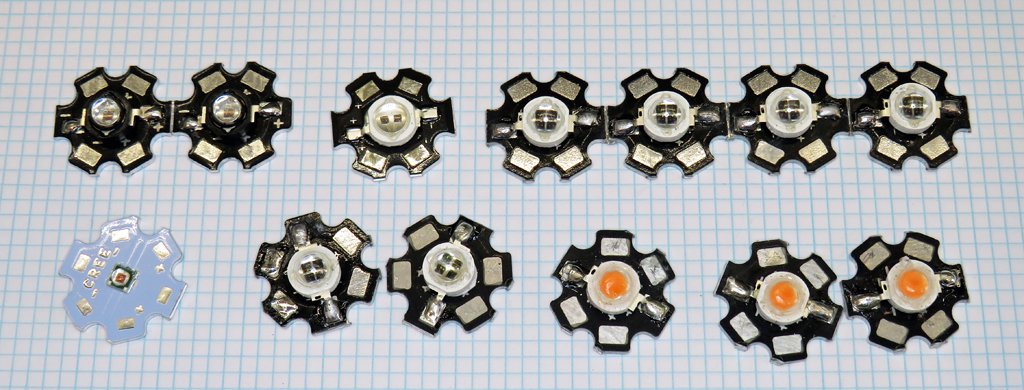
One thing to realize about these eBay LEDs is that their power claims are total BS. The "3W" and "5W" LEDs typically consume half that in electrical power. Considering that LED efficiency might be 50%, give or take, the 3W LEDs emit closer to 0.75W light and the 5W LEDs 1.25W light. Compare that to LED datasheets from legit manufacturers: Vishay VSLY5850 850nm T1-3/4 LED emits 55mW when driven with 100 mA at 1.65V (165 mW) for 33% efficiency. Osram SFH4550 850nm T1-3/4 LED emits 70mW when driven with 100 mA at 1.5V (150mW) for 47% efficiency.
| eBay LED | Claimed Watts | Wavelength | A | V | V Measured | V*A | Efficiency |
| 333734241333 | 10 | 620-630 | 3 | 2.2-2.4 | 3.24 | 9.72 | 103% |
| 122604065816 | 5 | 620-630 | 1.2 | 2-2.2 | 2.4 | 2.88 | 174% |
| 252050384162 | 5 | 740 | 0.7 | 1.8-2.2 | 2.17 | 1.52 | 197% |
| 263394692287 | 5 | 850 | 1.4 | 1.6-2 | 2.05 | 2.87 | 174% |
| 224457603330 | 5 | 850 | 1.4 | 1.6-2 | 1.98 | 2.77 | 180% |
| 202040649383 | 5 | 850 | 3.5 | 1.6-1.8 | 2.95 | 10.3 | 51% |
| 252174000311 | 5 | 940 | 1.4 | 1.3-1.6 | 1.72 | 2.41 | 207% |
| 321202626697 | 5 | 940 | 1.4 | 1.4-1.7 | 1.82 | 2.55 | 197% |
| 224457603330 | 5 | 940 | 1.4 | 1.6-2 | 1.63 | 2.28 | 219% |
Adding to the confusion is that visible LEDs are almost never rated in Watts as infrared LEDs are. Visible LEDs are measured in candelas which is a brightness measurement referenced to the spectral sensitivity of the human eye. There is no simple direct conversion to Watts. There is nothing to keep one from measuring the output of a visible LED in Watts but that requires a power meter, often including an integrating sphere, calibrated for that. Manufacturers probably assume that if it is a visible LED (approx 380nm to 750nm) that you are looking at it with your eye and a Watt of green (where our eyes peak) appears much brighter to us than a Watt of red light. Thus visible LEDs are measured with a system that accounts for the spectral sensitivity of the human eye.
Okay, these 'star' LEDs emit a lot of power, but at a typical 120-degree angle. What a waste! However, another eBay Chinese item changes everything. This very strange lens changes the beam angle of the star LEDs to 7 to 9 degrees.
These strange lenses are a game changer!
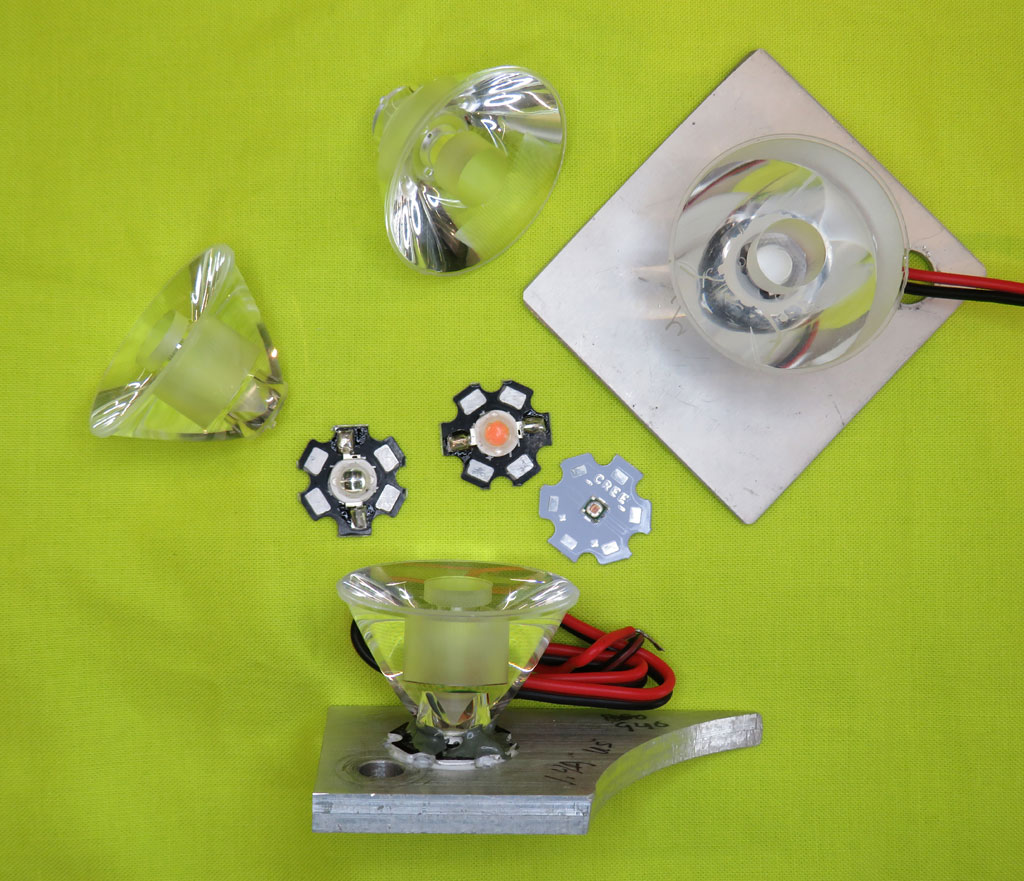
They are advertised as: "38mm Lens 3° Beam Angle For 3030 3535 5050 LED Or Cree XLamp XPE LED." 3-degrees? Do not bet on it. As usual for eBay items from China, an exaggeration. I have measured the beamwidths of combinations of star LEDs and these lenses using a 35-foot goniophotometer to be 7 to 8.5 degrees to the -3dB points. Not laser-tight, but still the result is a huge amount of optical energy in a small spot for a low cost. These lenses are under $2, the LEDs $2 to $4.
Another approach is to mount the LED in a box with a big Fresnel lens. Definitely not my goal. I am making a pair of transceivers. One for me and typically one for a VHF contest rover. The rover has a lot of other radios and antennas to carry in his vehicle. The optical contacts not being the main event for him. Huge plywood boxes with Fresnel lenses are definitely not appreciated. Compact, quick and easy to use equipment is necessary.
Note that these LEDs need to be mounted on heatsinks. I do this using 4-40 nylon hardware to avoid shorts. Heatsink grease or thermally conductive adhesive is advised. The lenses are attached with Loctite EA9340 heat resistant epoxy.
Safety Concerns...
These may just be LEDs, but they are incredibly bright. Eye safety has to be considered. I found an international standard that seems to apply, IEC 62471:2006/CIE S 009:2002 "Photobiological safety of lamps and lamp systems." I found it on what seems to be a Chinese site violating the copyright:
or
http://tbt.testrust.com/image/zt/123/100123_2.pdfIt is not my expertise to decipher government standards, but this is how I see it. Table 5.4 on page 55 "Summary of the ELs for the surface of the skin or cornea (irradiance based values)." [EL means Exposure Limit.] "Eye IR" 780 to 3000 nm for exposure >1000 seconds (worst case) 100 W/m2 constant irradiance.
Another Standard, ANSI/IES RP-27-20 Recommended Practice: Photobiological Safety For Lighting Systems, confirms this in A.3.5 Infrared Radiation Hazard Exposure Limit: "...over the wavelength range 770 nm to 3000 nm should be limited to 0.01W/cm2 for periods exceeding 1000 seconds." 0.01 W/cm2 = 100 W/m2.
Here I am just considering infrared. I am planning to use 850nm IR as well as visible red. The next most common high power IR LEDs are 940nm but none that I have measured seem to emit anywhere as much energy as the 850nm LEDs. At the start I only had instrumentation for infrared irradiance measurements. It's great that we have a number to work with. Now to measure irradiance of the wavelength of interest in W/m2. For that we need an irradiance meter. There is one available for about $200. Covers 760nm to 1100nm and directly displays the measurements in the needed W/m2 units.
Infrared Irradiance Meter.
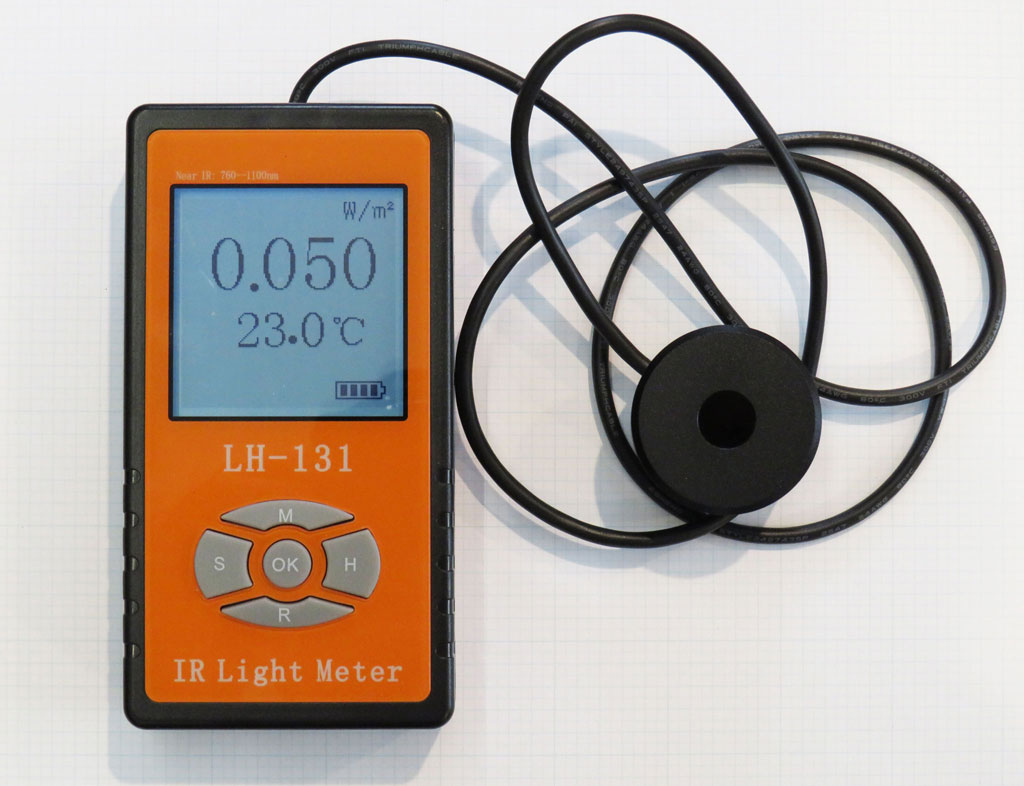
This meter showed me that I needed 26-inches distance from the front of one of the 850nm 5W LEDs with the cone lens to be under 100W/m2. And that's if you stared at the LED output for an extended length of time. Good news.
Note that for higher powers the standard calls for using the formula EL = 18000/t0.75 where t = seconds, <=1000 seconds.
I'm assuming if I understand this correctly it means the exposure limit is 3200 W/m2 for ten seconds. Yikes!
What about visible light, i.e.: red? The IEC standard says for a "Blue-light small source" of 300nm to 700nm the exposure limit is only 1 W/m2 for exposures of over 100 seconds, or 100/t for exposures under 100 seconds. The eye aversion response to bright light should provide some significant protection.
There are alternate ways to make this measurement. Note that every other irradiance meter I found was for UV light only which is of no interest. There are some solar irradiance meters which might be okay for visible light but I don't know if they might be more calibrated for the spectra of the sun which may or may not make a difference. One way is to use a known active area silicon photodiode and assume its responsivity (A/W) is typical for silicon, i.e.: about 0.45 A/W for red light, and do the math. I have done this at 850nm with two different photodiodes of known responsivity at that wavelength and found that they do agree well with my commercial IR irradiance meter.
For the visible red 10W star Cree LED with a cone lens my measurements indicated about a 20-foot distance was needed to meet the 1W/m2 exposure limit for 100 or more seconds exposure. Should be no problem in a controlled or uncontrolled environment. No risk to aircraft, for example.
Even Narrower Beamwidths?
Adding another lens can yield even narrower beamwidths at the expense of a bulkier receiver. I have tried an assortment of lenses from 250mm to 600mm focal lengths. For example, a 250mm FL lens reduced a visible red LED with a cone lens from 8.5 degree beamwidth to 3.75 degrees and tripled the effective brightness. A 500mm FL lens further reduced the beamwidth to 2 degrees and increased the effective brightness a bit more than three times. An additional lens adds about a foot to the length on a receiver.
Beamwidth test setup on my milling machine rotary table.
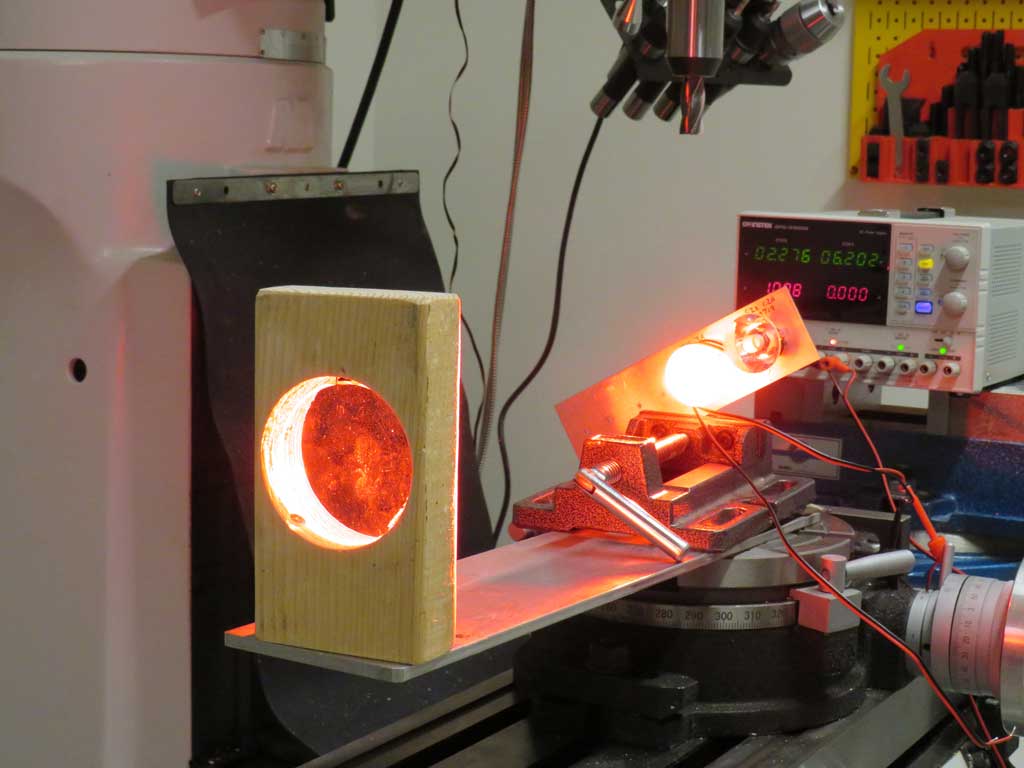
I made a tool useful for making relative intensity measurements and beam width measurements. It is simply a Texas Instruments OPT101 monolithic photodiode and single supply transimpedance amplifier IC mounted in a box with a 9V battery and a large meter movement. This 8 pin DIP IC provides a voltage output linear with light input. Spectral sensitivity is visible through infrared. The OPT101 is available at Amazon with a printed circuit board for a few dollars.
OPT101 Light Meter.
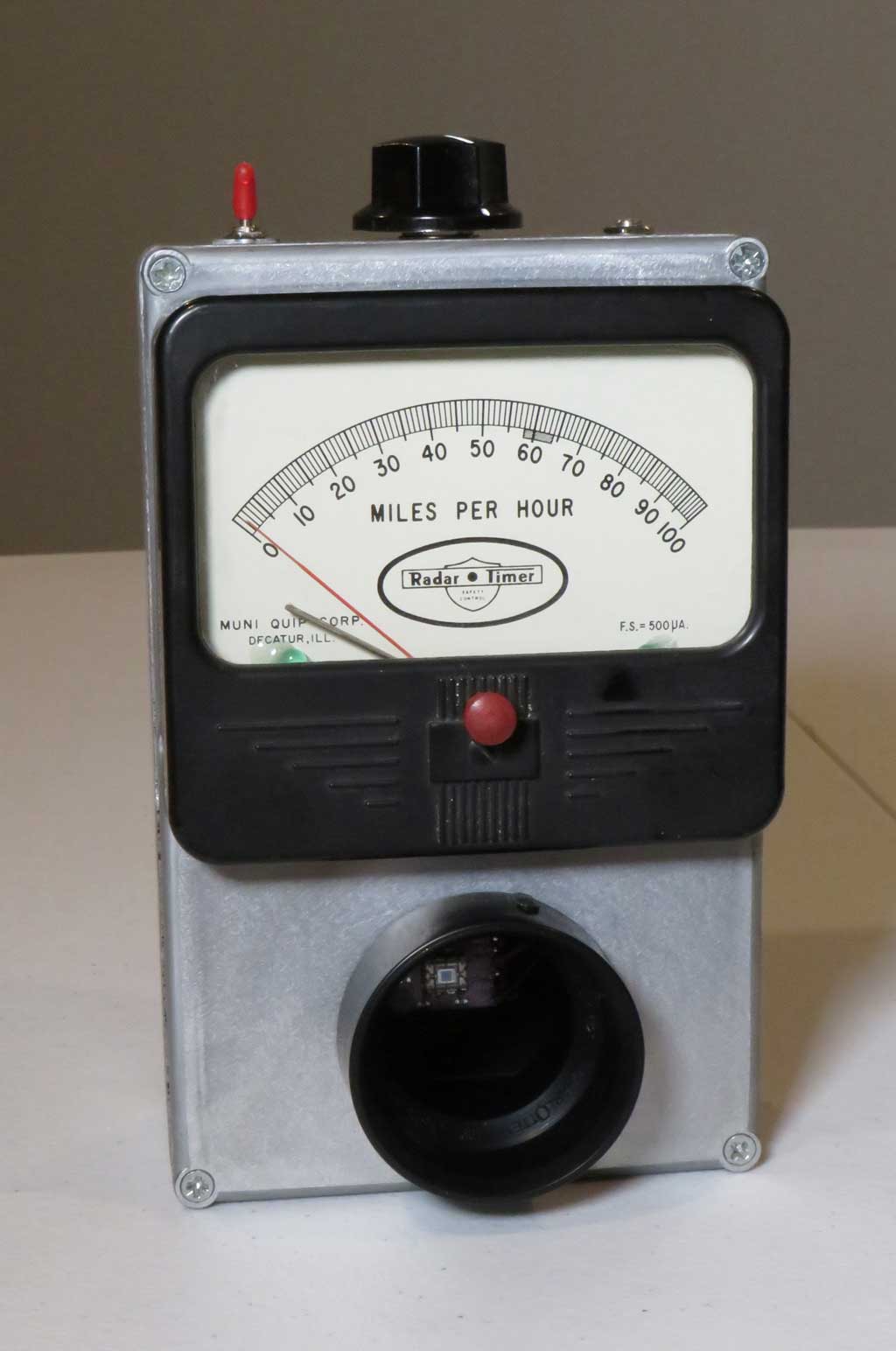
OPT101 Light Meter in use.
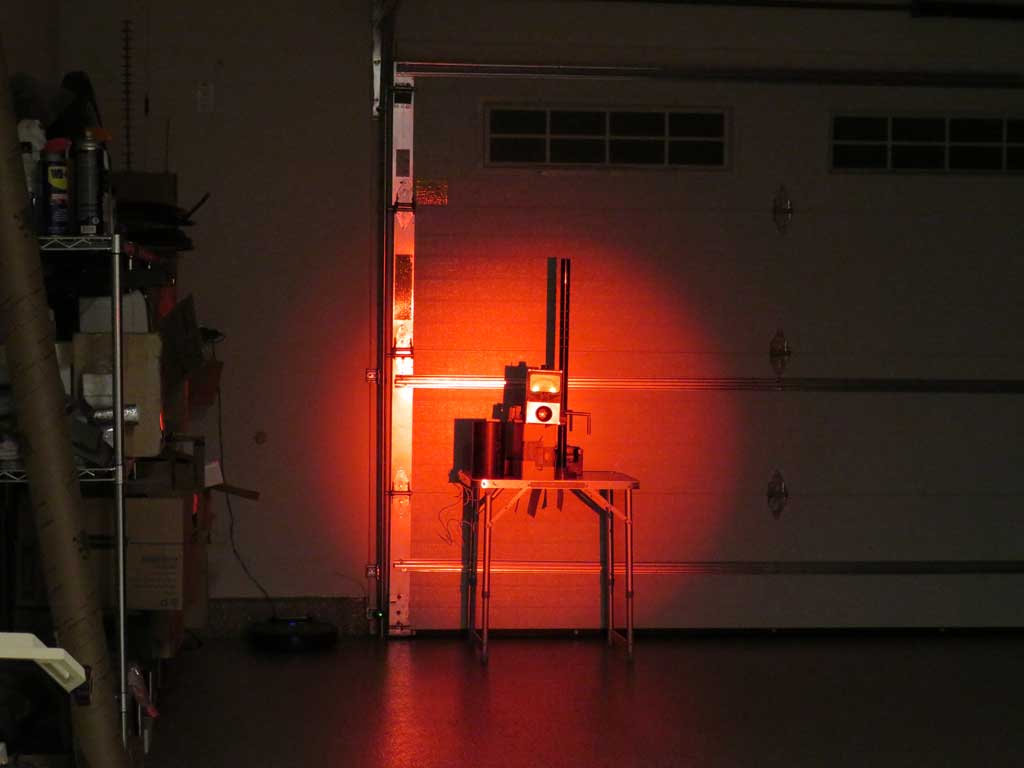
At this time I have not made the switch on my optical transceivers from the T1-3/4 LEDs to the high power star LEDs with the cone lens. I have a few more LEDs to test first.
New high power LED array being assembled.
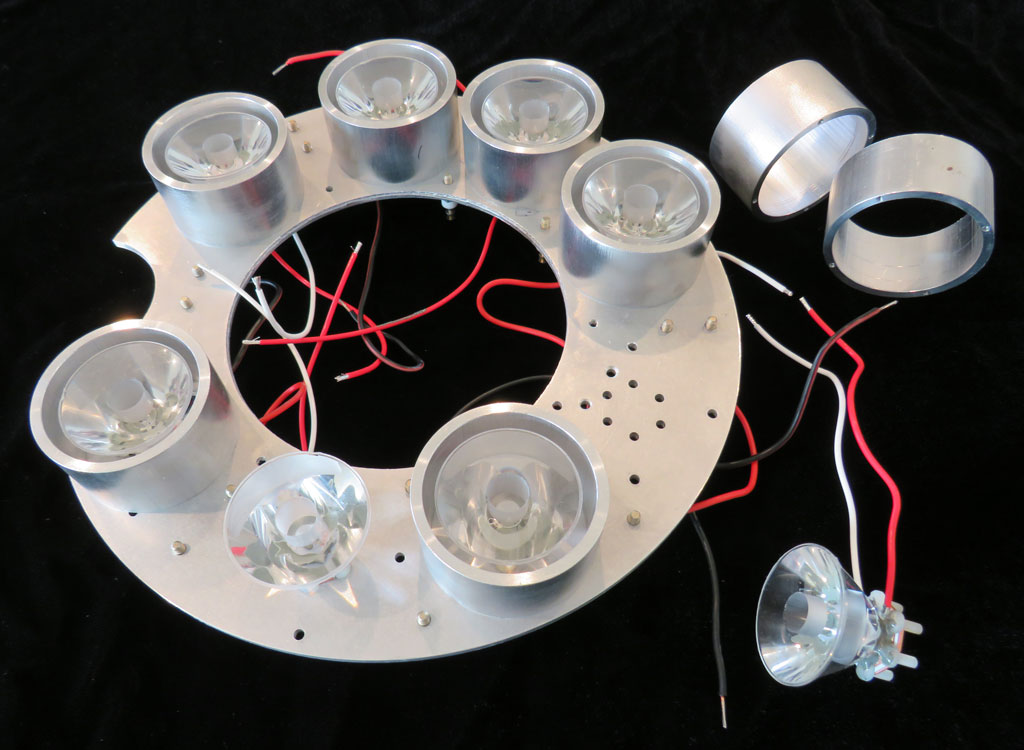
Thanks to Roger, K6LMN, for encouraging me in this endeavor.
73, Steve WA6EJO
Visit the largest used high-tech
electronic test and production equipment dealer directory on the net:
Used Electronic Test and Semiconductor Production Equipment Dealer Directory
Largest Thermoelectricity information site on the 'net:
Thermoelectricity information site... http://www.peltier-info.com
LED Light Emitting Diode spectral scans and measurements:
LED Spectral Scans... http://www.big-list.com/leds.html
Copyright © 2021. All rights reserved.